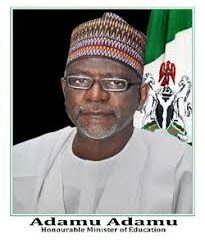Opinion
Making Digital Skills Meaningful to Girls and Women: A Journey to a Difficult Handshake and Conversation
Opinion
Why They Are Afraid Of Ganduje
By Abubakar Umar
While preparing to pen this write up I just scrolled the news and read that the Kano High court that ordered the suspension of the APC National chairman Dr Abdullahi Umar Ganduje have vacated the order pending the determination of the suit on 30th April.
From the look of things and with his glowing political clout since he joined politics in the second Republic Dr. Abdullahi Umar Ganduje the former Governor of Kano state is giving sleepless nights to many politicians particularly from his home state of Kano where the melting pot of Nigerian politics emanated from.
No vex his emergence as the National chairman of Nigerias ruling party has brought down the evil machinations of some politicians who sees Dr Abdullahi Umar Ganduje as a stumbling block to their political ambition at the national stage .
The administrator cum politician as many people will attest to knew very well that interms of experience and political calculations he has no match especially from the North West political zone where the National chairman hails from .
They know very well that the national working committee of the party and President Asiwaju Bola Ahmad Tinubu have done the right calculation by placing an elder politician and a two term Governor of the most difficult state to Govern in the whole Nigeria as the chairman of the Nigerian ruling party.
They knew very well that his stature has made him one of the most visible and hardworking APC National chairman since its formation in the year 2013.
The conscripted script being played by agents of destabilzation in order to make the ruling party irrelevant can only be done if they try to use some political zealots with the aim of making the National Chairman look like someone who can not sail through their evil conspiracy .
It was understood that the only way the NNPP Governent in Kano will change it’s political nest is to cut down the tree that is supposed to give it a shade but instead of humbling themselves and submit themselves to the party’s National Secretariat in which Dr. Ganduje is the leader they starte beating about the bush like a child’s play.
Dr.Ganduje had since humbled them politically and by visiting the state on January 25 ,2024 to invite them to the ruling party without vengeance .
He extended the hand of friendship that politics is is the ability to make sacrifices and compromise .
It was that compromise and sacrifice that made some of his political foes make accomplishments they never dream to achieve but still they are not grateful with the his sacrifice and patience .
Today the courts have vindicated by Dr.Abdullahi Umar and the APC national stalwarts across the country who are comfortable with the leadership style of Dr.Abdullahi Umar Ganduje.
Opinion
Celebrating Emir Sulu -Gambari at 84
By AbdurRaheem Sa’ad Dembo
Today the highly revered Emir of Ilorin, Alhaji (Dr) Ibrahim Sulu -Gambari CFR marks 84 years birthday.The former Jurist ascended the throne of his forefathers on Monday and he was also born on Monday. What a coincidence!
Being alive up to the age of 84 is a rare opportunity for anyone who really appreciate the homongous favour of the Almighty.The Chancellor of Bayero University Kano is an example of an Emir with a digital disposition and inclination.He believes so much in the progress of individuals and the entire Ilorin Emirate.
Dwelling so much about his career as a retired Justice of Court of Appeal may not be necessary as many are aware of it.The Emir stands out as a man who had made Ilorin as a City to move away from the old ways of doing things even in terms of education. He has encouraged scholarship in all ramifications. Be it in Islamic perspective and western education. Emir Sulu Gambari is the first University graduate to have ascended the throne in more two centuries of Ilorin Emirate history .
Before his ascension to the throne of his progenitors, Ilorin had a handful of professors but today they’re as many as possible.He has achieved a lot but you know traditionally such may not be made public.
Mai Martaba has provided purposeful and impactful leadership, this can be captured in the words of Abubakar Imam, the National Secretary of Ilorin Emirate Descendants Progressive Union IEDPU thus:
“The Emir has always taken care of the welfare and wellbeing of the ordinary people of his Emirate in words and actions. For instance, he initiated a Fund through which money was raised to address the immediate needs of the downtrodden people and residents of the community. The Fund was chaired by the Danmansani of Ilorin, Engr Sulaiman Ayinde Yahaya Alapansanpa, FNSE, while the immediate past National President of IEDPU, Alhaji Aliyu Otta Uthman, fsi, was the Alternate Chairman. Over 15,000 individuals from all the nooks and crannies of Ilorin Emirate benefited from the Fund during the course of the perilous COVID-19 epidemic, which rocked the humanity about five years ago. It will also be recalled that the Emir purchased 400 bundles of corrugated iron sheet, which was distributed to the less privileged members of the community who were affected by a devastating rainstorm in 2021. The then IEDPU President was given the task of getting the item delivered at the footsteps of the victims of the natural disaster”
Before the coming of Emir of Ilorin, University of Ilorin was not a place an Ilorin indigene can gain admission into easily.In fact, only few had opportunity to school there at that time.But Emir Sulu -Gambari and other stakeholders ensured that an indigenous Vice Chancellor was giving opportunity to lead the Ivory tower for the first time,in person of Professor Shuaib Oba Abdulraheem, the Talba of Ilorin Emirate .May Allah continue to grant Professor good health and plenty baraka. Professor Oba cannot even mention all those he has assisted, because the numbers are huge.
Today, there is fairness in the issue of admission into university of Ilorin.The standard was established by the administration of Professor Shuaib Oba Abdulraheem and has been sustained by his successors.
Eminent sons and daughters of Ilorin Emirate are already sending their warmest messages to the Emir.
Kwara State Governor AbdulRahman AbdulRazaq has rejoiced with the Emir of Ilorin and Chairman of Kwara state traditional rulers Council
The Emir, according to the Governor, “has remained a father to all while also deploying his rich experiences and networks to support not just the people of the Ilorin Emirate but also the people of the state as a whole.
The Governor prays to Allaah to give His Royal Highness good health and long life, and continue to uphold him upon goodness in his service to the people of the Emirate”
The Turaki of Ilorin Emirate and Senator representing Kwara Central senatorial district, Senator Saliu Mustapha has also congratulated the His Royal Highness, Alhaji (Dr) Ibrahim Sulu-Gambari CFR, on the occasion of his 84th birthday anniversary
Senator Mustapha described the revered Emir who is a retired eminent jurist as “an ambassador of peace with an admirable style of leadership”
He affirmed that since the respected monarch’s ascension to the throne of his forefathers in 1995 as the 11th Emir of Ilorin, he has brought a lot of development and glamour to the entire State.
While extolling the emir’s humility and modernized vision for his domain and the country at large, Senator Mustapha prays God Almighty to grant the royal father more years of worthy service to his people and humanity in good health.
Furthermore,Honourable Mukhtar Tolani Shagaya representing Ilorin West/Asa Federal Constituency also greeted the Emir “His Royal Highness has exemplified wisdom, compassion, and integrity throughout his reign, serving as a beacon of hope for the people of Ilorin and beyond. His visionary leadership has brought about tremendous growth and development, with a keen focus on fostering unity and inclusivity amongst his subjects. His unwavering dedication to our collective well-being is a testament to his selflessness and genuine concern for his people”
Under his guidance, Ilorin has witnessed a remarkable transformation, with strides made in education, healthcare, infrastructure, and socio-economic development. His Royal Highness’s commitment to fostering a harmonious and prosperous society has played a pivotal role in shaping the Ilorin of today – a thriving community that takes pride in its rich cultural heritage while embracing the promise of a brighter future”
Similarly, A former Member of the House of Representatives, Hon. Abdulwahab Oladimeji Issa has felicitated the Emir of Ilorin.He extolled the Emir thus,”his uncommon leadership qualities” and prayed that God grants him many more years of service to the people of Ilorin emirate and Nigeria.
“As you mark your 84th birthday anniversary which comes up today Monday, April 22nd, 2024, I write, on behalf of my family to extend warm felicitations to Your Highness.
“Only recently, you marked twenty-eight years of unquantified success on the throne as the Emir of Ilorin. Your uncommon leadership qualities and evident faith in the peace, unity, progress, and prosperity of the Ilorin emirate and beyond, have combined to make you one of the most highly respected monarchs in Nigeria today.
“As you continue to use your exalted throne to build bridges of friendship and harmony across Kwara state and the nation, it is my prayer that Almighty Allah grants you many more years of abounding health, prosperity, and enduring fulfillment,” he added.
Hajiya Arinola Lawal also felicitates Emir of Ilorin on 84th birthday anniversary,
“I extend my warmest wishes and heartfelt prayers to His Royal Highness, Alhaji Ibrahim Sulu-Gambari, the Emir of Ilorin, on the occasion of his birthday
I beseech Allah to grant His Royal Highness a long and prosperous reign on the throne of his fathers, filled with peace, stability, and blessings for the Ilorin Emirate”
Meanwhile, LT Col Ramat Suleiman also joined the league of prominent Ilorin Emirate sons and daughters to celebrate the Emir Sulu -Gambari at 84.She described the Emir as a father to all and a lover of peace.The first Ilorin Emirate woman to have attained the rank of LT Col in the military extolled the Emir as a leader with great vision and prayed to Allah to grant him good health and more years ahead on the throne of his forefathers.
Professor Shuaib Oba Abdulraheem,Senator Ibrahim Yahaya Oloriegbe, Honourable Moshood Mustapha,Former Senate President, Abubakar Bukola Saraki, Hajiya Tundun Alanamu, Barrister Oba Magaji and others have also greeted the Emir at 84.
By way of conclusion,without mincing words Ilorin Emirate has witnessed tremendous transformation under the leadership of Emir Sulu -Gambari in all facets of the Emirate since his ascension in 1995.I wish the Emir a prosperous, healthy and pious 84th birthday anniversary and more years ahead Insha Allah.
Sheeeehuuuu.Walahu ya’simuka minna nas
abdurraheemsaaddembo@gmail.com
Opinion
For Adamu A Zango:Simple Solution To Your Compounded Problems
Tijjani Muhammad Musa
I usually don’t like writing on celebrities except if the issue borders on religious matters. Even so, it’s not any trivial matter that makes my ink flow. For me, talking to stars is like calling on someone who has taken a turn.
But once in a while, I do make an exception when it comes to situations that need prompt intervention towards saving a soul that’s heading to the edge of the abyss. I have succeeded on one or two cases though. AlhamdulilLaah
And lately, with so much misfortunes befalling guys in the Arewa entertainment industry, most especially Kannywood, one can’t help but smell the unpleasant stench in the air, and thus whiff the hand to ward it off.
This brings us to the latest trending issue of Adamu A Zango’s depression crisis. Those concerned about him have been raising alarm on social media of an impending doom that could likely befall him if he is not counselled on time.
Well, it’s that serious. Many say he needs help urgently and beg those who can to approach him and save actor cum musical icon from himself. Those close to him should as a matter of urgency do. For us from afar, we can only submit thus:
The perfect solution to Adamu A. Zango’s problem and dilemma much as some wouldn’t want to hear it can be found in the Holy Qur’an Surah Al-Anbiya (21) verses 83-84 where Allaah SWT Says:
83. And (remember) Ayyûb (Job), when he cried to his Lord: “Verily, distress has seized me, and You are the Most Merciful of all those who show mercy.”
84. So We answered his call, and We removed the distress that was on him, and We restored his family to him (that he had lost) and the like thereof along with them as a mercy from Ourselves and a Reminder for all those who worship us.
Again relate to the same Surah Q21:87-88 which brings forth how Yunus AS was able to free himself from utter hopelessness into Allaah’s Grace and Mercy. Note the Promise of Allaah SWT to grant others who worship Him similar grace if they should repeat same du’a.
So Adamu, first you must prepare your mind by connecting to your Lord, sincerely seeking His Graceful intervention in your matters. How? Sincere repentance is key and subsequently seek for forgiveness for all your bad deeds.
Next abstain from all acts of disobedience to Allaah. Thereafter, perform 2 raka’at of Salah, after which you should engage in DhikrAllaah, reciting the du’a of Ayub AS in Q21:83 and Yunus AS in Q21:87
Finally, form the habit of reciting the Qur’an and listening to it on a regular basis. Always perform your 5 daily obligatory prayers in congregation and keep off anybody or anything that will constitute a distraction to your focus on your developing a close relationship with your Lord Allaah AWJ.
If you can take these few simple, but highly challenging steps and implement them in your life, it is a guarantee that you will be free from all these stresses and distresses to a life of unprecedented peace bi iznilLaah..
But as a Kannywood and Hausa music celebrity, this solution though simple as it may seem might be the most difficult thing for you to adopt. And I believe you know why. And that sadly is where the problem truly lies.
Unless one is ready to embrace a change of lifestyle from his or her norm to Allaah’s laid out norms, things in life will keep challenging their peace and tranquility of the person.
Hope this helps .
Tijjani Muhammad Musa is the chairman Association of Nigerian Authors Kano branch
*©2024 Tijjani M. M.*
All Rights Reserved
-

 Features3 years ago
Features3 years agoHow I Became A Multimillionaire In Nigeria – Hadiza Gabon
-

 History3 years ago
History3 years agoSheikh Adam Abdullahi Al-Ilory (1917-1992):Nigeria’s Islamic Scholar Who Wrote Over 100 Books And Journals
-

 Opinion2 years ago
Opinion2 years agoOn The Kano Flyovers And Public Perception
-

 Opinion3 years ago
Opinion3 years agoKano As future Headquarters Of Poverty In Nigeria
-

 History3 years ago
History3 years agoThe Origin Of “Mammy Market” In Army Barracks (Mammy Ochefu)
-

 News2 years ago
News2 years agoFederal University Of Technology Babura To Commence Academic Activities September
-

 Opinion2 years ago
Opinion2 years agoMy First Encounter with Nasiru Gawuna, the Humble Deputy Governor
-

 Opinion3 years ago
Opinion3 years agoKhalifa Muhammadu Sanusi II, A Phoenix Rises